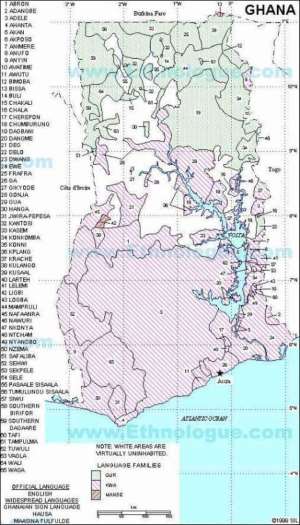
IN 1960, roughly 100 linguistic and cultural groups were recorded in Ghana. Although later censuses placed less emphasis on the ethnic and cultural composition of the population, differences of course existed and had not disappeared by the mid-1990s. The major ethnic groups in Ghana include the Akan, Ewe, Mole-Dagbane, Guan, and Ga-Adangbe. The sub-divisions of each group share a common cultural heritage, history, language, and origin. These shared attributes were among the variables that contributed to state formation in the pre-colonial period. Competition to acquire land for cultivation, to control trade routes, or to form alliances for protection, also promoted group solidarity and state formation. The creation of the union that became the Asante confederacy in the late 17th century is a good example of such processes at work in Ghana’s past. Ethnic rivalries of the pre-colonial era, variance in the impact of colonialism upon different regions of the country, and the uneven distribution of social and economic amenities in post-independence Ghana have all contributed to present-day ethnic tensions. For example, in February1994,more than 1,000 persons were killed and 150,000 others displaced in the north-eastern part of Ghana in fighting between Konkomba on one side and Nanumba on the other side, and Nanumba, Dagomba, and Gonja on the other. The clashes resulted from long-standing grievances over land ownership and the prerogatives of chiefs. A military task force restored order, but a state of emergency in the region remained in force until mid-August. Although this violence was certainly evidence of ethnic tension in the country, most observers agreed that the case in point was exceptional. As one prolific writer modern Ghana, Naomi Chazan, has aptly observed, undifferentiated recourse to ethnic categories has obscured the essential fluidity that lies at the core of shared ties in the country. Evidence of this fluidity lies in the heterogeneous nature of all administrative regions, in rural-urban migration that results in inter-ethnic mixing, in the shared concerns of professionals and trade unionists that cut across ethnic lines, and in the multi-ethnic composition of secondary school and university classes. Ethnicity, nonetheless, continues to be one of the most potent factors affecting political behaviour in Ghana. For this reason, ethnically-based political parties are unconstitutional under the present Fourth Republic. Despite the cultural differences among Ghana’s various peoples, linguists have placed Ghanaian languages in one or the other of only two major linguistic sub-families of the Niger-Congo language family, one of the large language groups in Africa. These are the Kwa and Gur groups, found to the south and north of the Volta River, respectively. The Kwa group, which comprises about 75 per cent of the country’s population, includes the Akan, Ga-Adangbe, and Ewe. The Akan are further divided into the Asante, Fanti, Akwapim, Akyem, Akwamu, Ahanta, Bono, Nzema, Kwahu, and Sefwi. The Ga-Adangbe people and language group include the Ga, Adangbe, Ada, and Krobo or Kloli. Even the Ewe, who constitute a single linguistic group, are divided into the Nkonya, Tafi, Logba, Sontrokofi, Lolobi, and Likpe1. North of the Volta River are the three sub-divisions of the Gur-speaking people. These are the Gurma, Grusi, and Mole-Dagbane. Like the Kwa sub-families, further divisions exist within the principal Gur groups. Any one group may be distinguished from others in the same linguistically-defined category or sub-category, even when the members of the category are characterised by essentially the same social institutions. Each has a historical tradition of group identity, if nothing else, and, usually, of political autonomy. In some cases, however, what is considered a single unit for census and other purposes, may have been divided into identifiable separate groups before and during much of the colonial period and, in some manner, may have continued to be separate after independence. No part of Ghana, however, is ethnically homogeneous. Urban centres are the most ethnically-mixed because of migration to towns and cities by those in search of employment. Rural areas, with the exception of cocoa-producing areas that have attracted migrant labour, tend to reflect more traditional population distributions. One overriding feature of the country’s ethnic population is that groups to the south who are closer to the Atlantic coast have long been influenced by the money economy, Western education, and Christianity, whereas Gur-speakers to the north, who have been less exposed to those influences, have come under Islamic influence. These influences were not pervasive in the respective regions, however, nor were they wholly restricted to them. .....Get Detailed Information....




 We’ll no longer tolerate your empty, unwarranted attacks – TUC blasts Prof Adei
We’ll no longer tolerate your empty, unwarranted attacks – TUC blasts Prof Adei
 Bawumia donates GHc200,000 to support Madina fire victims
Bawumia donates GHc200,000 to support Madina fire victims
 IMF to disburse US$360million third tranche to Ghana without creditors MoU
IMF to disburse US$360million third tranche to Ghana without creditors MoU
 Truck owner share insights into train collision incident
Truck owner share insights into train collision incident
 Paramount chief of Bassare Traditional Area passes on
Paramount chief of Bassare Traditional Area passes on
 Two teachers in court over alleged illegal possession of BECE papers
Two teachers in court over alleged illegal possession of BECE papers
 Sunyani: Victim allegedly shot by traditional warriors appeals for justice
Sunyani: Victim allegedly shot by traditional warriors appeals for justice
 Mahama vows to scrap teacher licensure exams, review Free SHS policy
Mahama vows to scrap teacher licensure exams, review Free SHS policy
 Government will replace burnt Madina shops with a new three-story, 120-store fac...
Government will replace burnt Madina shops with a new three-story, 120-store fac...
